 |
|
 |
2024
December
31
|
2024 in review
The end of 2024 finds us keeping a relatively even keel, with no dramatically important
events in recent months.
Sharon is perceptibly healthier than a year ago, and Melody has recovered, mostly, from her
two fractures.
I've kept busy and have racked up yet another year without
going to the Deerlick Astronomy Village (except that Melody and I rode by there in the daytime
a few months ago to see if anything had changed and to make sure my gate code still works).
But this partly reflects my shift toward astrophotography of a kind that doesn't require such a
dark sky. I have new deep-sky and planetary cameras and a new computer.
During the Christmas holidays, instead of astronomy, I'm turning my attention to microcontrollers
and finally getting caught up with the state of the art (Raspberry Pi Pico). I decided to more or
less skip the Arduino era; I may eventually use the small amount of Arduino hardware that I own,
or possibly give it away. I also have a conventional (Linux-based) Rasbperry Pi, a few years old,
that I haven't taken out of its box. ¡Mañana!
Nationally, politics is normalizing in an odd way — we have an incoming administration about
whom nobody is enthusiastic, not even those who, a few months ago, were its strongest supporters.
I expect mediocre leadership, but I also expect checks and balances to kick in so that nobody
can actually enact policies very far out of the mainstream. That is as it should be.
I'm also increasing my writing activity, particularly for the AskWoody
newsletter. After a multi-year slump, there again seems to be some demand for good writing.
So I won't be doing quite as much of it gratis in the Daily Notebook.
We wish everyone a happy, healthy, and prosperous 2025!
Permanent link to this entry


|
2024
December
26
|
Microcontrollers in a new era
One of the things my family gave me for Christmas was some free time for my own pursuits —
I won't exactly call this particular one a hobby because it impinges on my profession.
I finally found time to try to catch up with microcontroller technology.
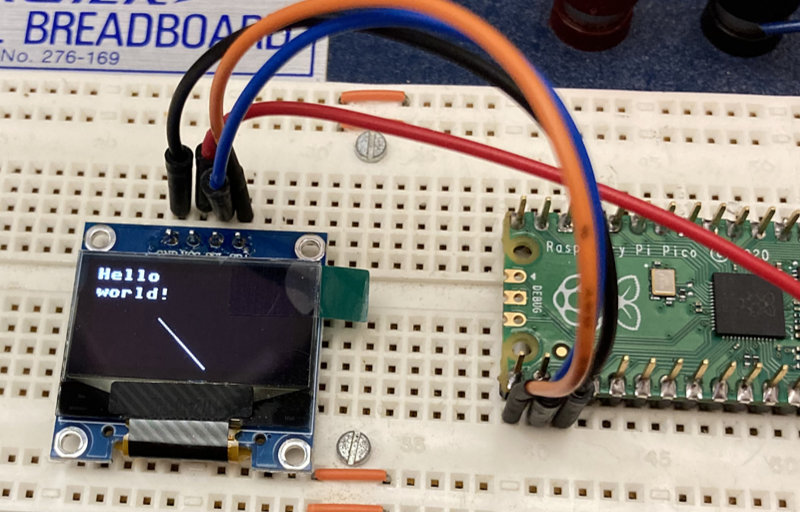
I've been experimenting with microcontrollers since the 1990s and even taught a 68HC11-based
microcontroller course at UGA twice. But times have changed. The
Arduino
came along and made microcontroller projects far easier to create.
I bought some Arduinos — starting twelve years ago! — but only found time to learn
the most basic things about how to use them.
This year I decided to simply skip over the Arduino era and learn to use what I think is now the
best micro for small projects, the Raspberry Pi Pico.
Whereas the Arduino is a low-end microcontroller with an unprecedently good toolchain,
the Pico is a high-powered dual-core ARM Cortex computer that runs Python — and costs $4.
It's unrelated to the mainstream Raspberry Pi, which is a Linux-based embedded computer starting at $6,
but is from the same project.
The idea with the Pico is to use a really generous amount of computer power to make development really easy.
For simple control and measurement applications, you need far less computer power than it offers.
You could easily use a PIC or AVR. And that would be the right thing to use if you were going to manufacture
something by the thousands — a $1 processor and a week or two of programmer's effort.
With the $4 Pico, I can get something built very quickly, making it far more economical for one-off
and experimental work.
Some things to note:
- If you need an extremely low-power sleep mode, you still need a PIC, AVR, or possibly cut-down Arduino design (AVR with firmware).
- The Pico is a 3.3-volt device (taking external 1.8- to 5.5-volt power). If you need to take input from
5-volt logic devices, you might need an Arduino. But since 3.3-volt and 5-volt logic levels are largely
compatible, the Pico can drive inputs of 5-volt periperals, in general.
- If you need multiple USB ports, other periperhals, and an operating system, you want the
conventional Raspberry Pi.
I am of course writing up a notebook, which may turn into a small self-published book.
Permanent link to this entry


|
2024
December
25
(Extra)
|
Christmas came

This year we had an orderly, low-key, adult Christmas, just the three
of us at home. The traditional lasagna was made, and Sharon rose to the occasion
in a special way. A few months ago I discovered that I can't digest lactose (nor,
to some extent, fructose), and taking Lactaid capsules doesn't entirely fix it.
So Sharon learned how to make lactose-free cheese at home, and after she had made
major batches of ricotta and mozzarella, she made our traditional Christmas lasagna.
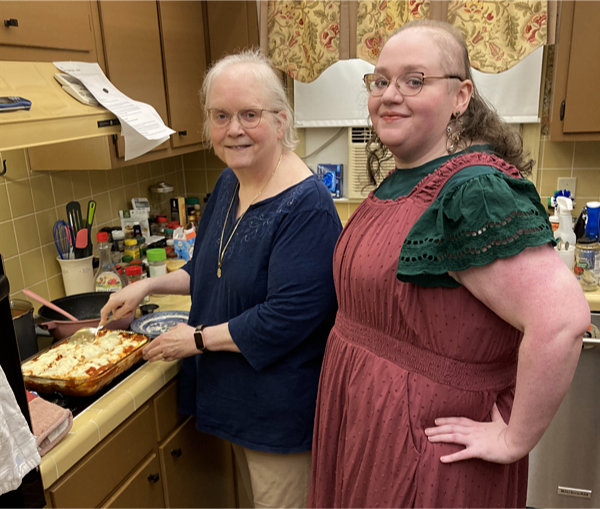
We showered Sharon with presents, including an Otamatone (electronic musical instrument
used by Japanese schoolchildren) and a hair dryer. I gave Melody
a book about some characters she knew in art school.
Sharon gave me a graphic novel about Superman defeating the Klan —
a good story, based on the Superman radio show in 1946 and giving a slightly earlier
version of his story than the comic books I read in the 1960s. Sadly, because I was
fighting a cold, we didn't make it to church. But we have much to be thankful for right
now, including, we hope, the next chapter in Sharon's medical treatment.
My thought for my fellow Christians is: We are celebrating an invasion.
God took human form to disrupt things and turn them right side up.
Christmas is something He did to the world, not the other way around.
Permanent link to this entry
Tannenbaum or Tännenbaum?
Right now I'm listening to someone on a CD singing "O Tännenbaum" (with all the words in English except
those two).
People who know German assure me the word is "Tannenbaum" without the umlaut
(that is, it is pronounced TAHN-en-boum, not TENN-en-boum).
What is going on here? I'm a linguist, and I wonder about such things. I haven't been able
to get the whole story, but apparently:
- In some dialects of German, and in Yiddish, Tannenbaum changed to Tännenbaum (Tenenbaum).
- English speakers assume that when they see Tannenbaum it might well be Tännenbaum typed
by someone on an English keyboard. So if they are unsure, they put in the umlaut.
By the way, I have never seen Taenenbaum [sic], which is what you would actually type if you had to
type the umlaut and had no way to put two dots over the a.
I would be glad to hear from anyone with more details. (Not just someone who knows German and can tell me how
it is normally spelled; I already know that. But someone who has encountered the relevant dialects and knows
the usage in detail.)
Permanent link to this entry


|
2024
December
25
|

Permanent link to this entry


|
2024
December
24
|
Web design in this modern age
While trying to read an online article about nutrition yesterday, I was
confronted with this monstrosity:

The designers of the web site got so excited interrupting everything with an ad on top of it,
that they stacked so many layers of interruptions that the original article was not visible
at all.
Admittedly I was on a 14-inch laptop. This may be partly an instance of the fact that when a web
designer gets a giant screen, he or she starts designing only for giant screens.
But it's also somewhere between foolishness and petty dishonesty. Somebody is wanting to get paid for displaying the ads,
but not actually display them where anybody can read them. (Every ad is hidden by another ad.)
I've noticed that Python programming web pages are often bedecked with excessive advertising like this.
There are articles whose titles offer to answer important questions, but the answer is incomplete,
written in bad English, and hidden under piles of advertising.
Permanent link to this entry
Jazz and Skibidi
For 20 or 30 years before it became the name of a kind of music, jazz was a word with a very vague meaning.
It was fashionable in some circles, but it meant something unclear having to do with energy or liveliness.
A few people thought it referred to something sexual, but apparently, most didn't. It was just a
fashionable word.
Of course, it didn't become widely used until it became the name of a new kind of music that needed
a name. That's normal. A word comes into wide use when it expresses something people need to express.
I thought of this while trying to find out what skibidi means. It's a fashionable word in
teenage slang, but the meaning is very vague — apparently the nearest I can get is that
it means "strikingly good" or "strikingly bad" or simply "attention-getting." But even in saying that,
I am analyzing it more deeply than the people who use it do.
I don't expect it to enter mainstream English unless it can acquire a clearer meaning.
This brief observation is offered in honor of William Labov,
pioneer of sociolinguistics, who died last week. He changed the direction of linguistics by pointing out that
the key to language change is people's attitudes toward language variation in their own place and time —
that is, we can see historical linguistics happening — we don't have to wait for historical records.
May his memory be eternal.
Permanent link to this entry
Two notes from food science
If you heard that black plastic cooking utensils are toxic — they're not.
Details
here. The researchers had made a mistake and overestimated the amount of a contaminant by a factor of 10.
Of course, some people will not be able to stop believing black plastic is toxic merely because the evidence for it has gone away.
One of the problems with public opinion is that too many people can't take in new information.
We saw that with the "vaccines cause autism" issue, which some people still believe even though
the study was found to be mistaken and retracted.
Vaccines didn't cause autism back when they contained mercury, and anyhow, they don't contain mercury now, and haven't for 25 years.
But some people can't revise their beliefs. They remind me of the scattered yokels who thought World War II was still going on
years after it ended.
A second note: People warn us about "ultraprocessed" foods. The trouble is,
"ultraprocessed" does not have an exact meaning (numerous writers make this point).
You need to pay attention to what's actually in the food. One brand of sliced turkey, for instance,
may have a lot less salt and preservatives than another. Choose your foods based on real facts,
not just the feeling that something is "natural" or unnatural.
Permanent link to this entry


|
2024
December
21
|
South Georgia
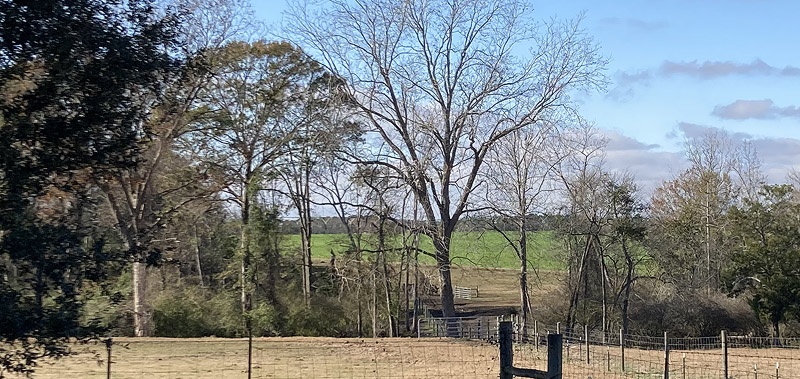
I went to Tony's funeral on December 19, making a one-day trip of it — leaving Athens at 8 a.m.,
going down via Madison and Gray (where there was lots of what I call "road constriction"), attending
the funeral and a brief lunch, and heading back north on the longer all-freeway route through Atlanta.
This was my first trip to South Georgia since 2015.
(With Melody's limited mobility, we don't travel much these days.)
The funeral was at Cool Springs Free Will Baptist Church, where I had been 66 years ago, as an infant,
for Tony and Betty Jean's wedding (no, I don't remember it).
I saw several cousins I hadn't seen in many years, and I was haunted by the question of
whom I was seeing for the last time.
In the picture above, you see the view from Cool Springs Church looking in the direction of my Roberts
grandparents' place on Livingston Bridge Road. (I'm told you can see the house from roughly here, but I
didn't succeed in doing so.) I'm glad to know that that 1870s farmhouse, which the Roberts family acquired
in the 1930s, and where my mother grew up, is still in use by one of my cousins. For a while about twenty
years ago, it was vacant, and I didn't know what would happen to it.
We have become a diverse family. The crowd included farmers who are still doing very much what their grandparents
did, on the same farm, all the way up to at least two Ph.D.'s, one Ed.S., and — when another cousin finishes
her studies — two Yale and one Harvard alumni.
Permanent link to this entry
Artisanry

My practical accomplishment of the day was to craft a replacement handle for this laundry
basket. I think it came out decently. This basket is part of a matched set that nest
together and all fit our cart; this size (Sterilite 1214) is no longer made.
Permanent link to this entry


|
2024
December
16
|
Tony E. Branan, 1938-2024, engineer

I am sad to report that my uncle, Tony E. Branan, died on December 13.
Click here for the obituary.
He was the husband of my mother's youngest sister and was the first person
in my mother's extended family to have a postgraduate degree
(the first to have any college degree, I think).
When my father died when I was 9, Uncle Tony stepped in to keep encouraging my avid
interest in technology, and more generally in science and in getting a good education.
He and Aunt Betty Jean actually took my mother, sister, and me into their home for
three weeks in the summer of 1967 when my father's estate was tied up and we didn't
have a house to live in.
More than that, Tony was, for me, a role model of how to be an educated person,
a responsible applied scientist, and a sincere Christian.
It was he that accompanied me to the University of Georgia's National Merit recruitment day
in October of 1972. That was the day I decided to come to UGA. And I was one of the
volunteers helping the University host the same event in 1975, at which I met an amazing
young lady named Melody Mauldin, and the rest is history.
His master's thesis, which I looked at when I was 9 years old, was the first postgraduate thesis
I had ever seen, and it really impressed me. Since then I have of course written one
of my own and supervised probably more than a dozen.
In Uncle Tony's honor, today I went to the appropriate University library and looked at
the University's copy of his master's thesis.
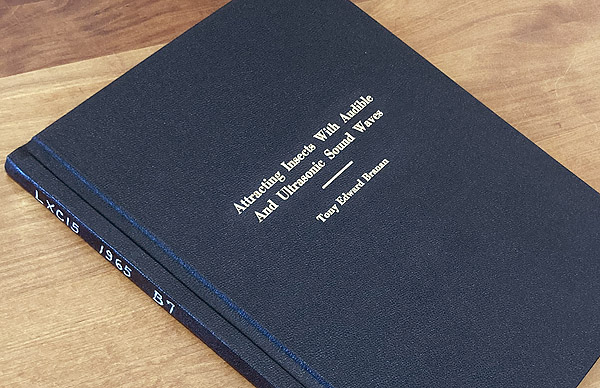
Reading it as a graduate faculty veteran rather than as a child, I still think it is
a good thesis. The main idea is ahead of its time: use non-chemical means to control
insects. Uncle Tony had read Silent Spring (1962) and was one of the first to look
for alternatives to the wide use of insecticides. The librarian was impressed when I
told her this.
I also congratulate him for having the gumption to publish a largely negative result.
He didn't come up with a miraculous way to control insects. But he did establish that
houseflies (at least) respond more to frequency than to loudness, and he devised equipment
that others could use for related experiments in the future. A negative result is,
after all, a result. We shouldn't think of it as something that didn't work, but rather
as a discovery that something isn't there.
I want to share with you a few pages of his thesis. The professional photography and
drafting particularly impressed me — they were normal practice in the 1960s; thank
goodness for digital cameras and graphics software today.
Please note that what I am showing you is NOT private unpublished schoolwork.
A thesis is a public document. It's in the University library (and, usually, also the
department library) for everyone to see. Theses are often distributed widely;
mine (though not Tony's) was published in an academic journal.
So here are some memorable pages (hastily photographed with a cell phone). Enjoy! And may Tony's memory be eternal.
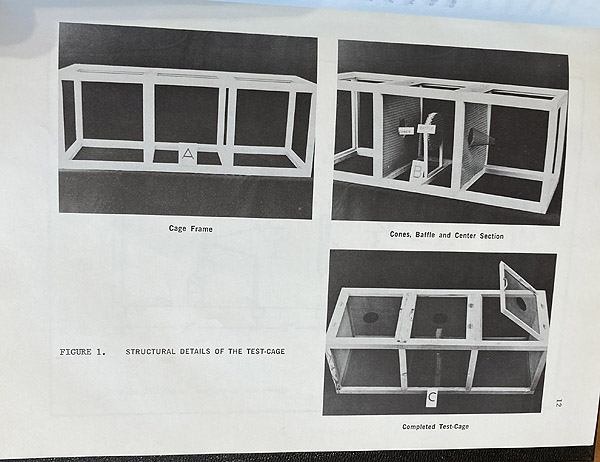
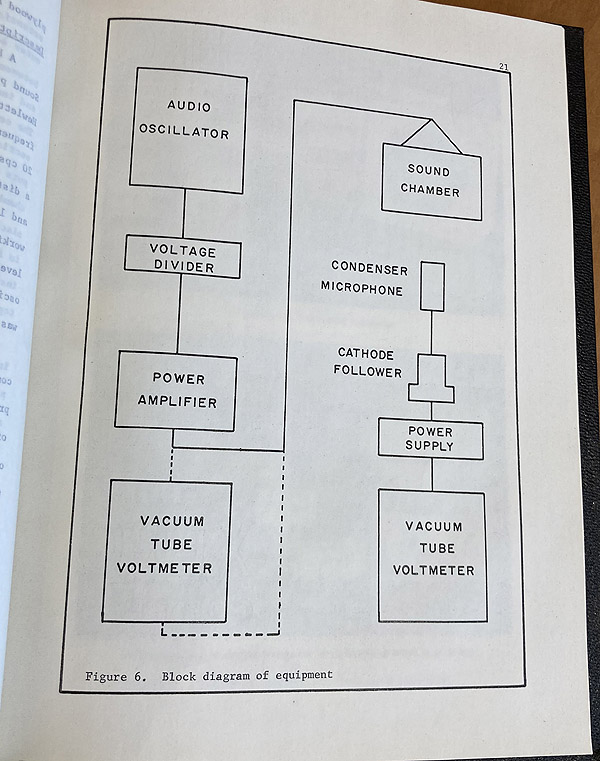
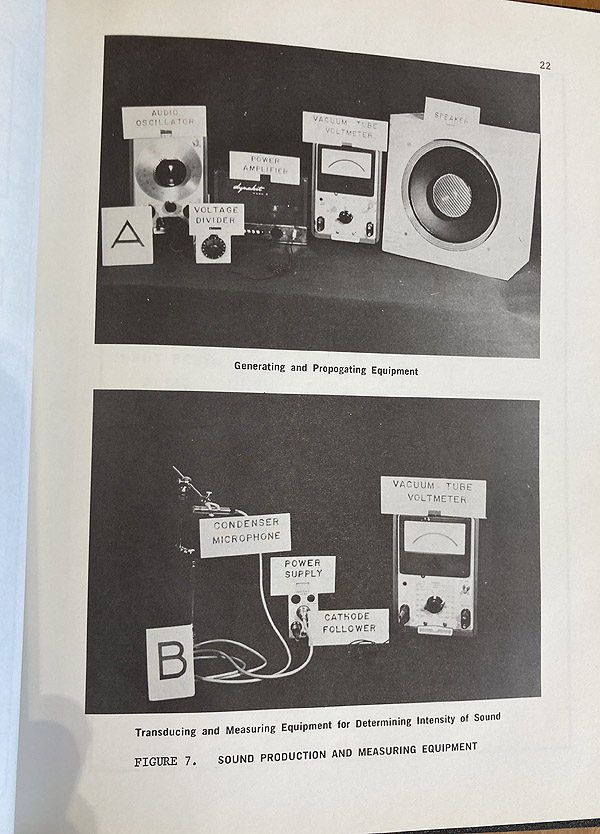
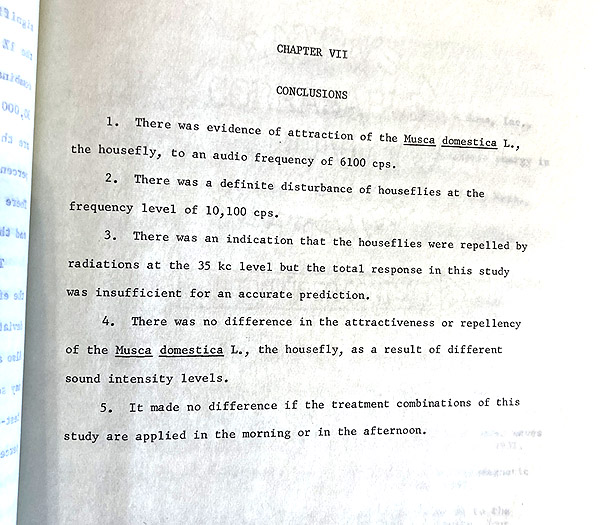
Permanent link to this entry


|
2024
December
15
|
Attilla Danko and ClearSkyChart
(formerly ClearSkyClock)

For many years, astronomers amateur and professional have benefited from charts like this one,
which show whether the sky will be clear and the air will be steady, hour by hour, for several days
into the future, at any given location. They are hosted at https://www.cleardarksky.com/csk/.
They are the brainchild of the late Attilla Danko, who created this service. It digests maps
from Environment Canada (also covering 49 of our states) and presents the information spread over time instead of space.
Mr. Danko died last month (may his memory be eternal), and his widow is able to maintain the service for now, but does not
feel qualified to keep it up for a long time. (Details here.)
We definitely need to thank him for his service, and find someone to take over providing it.
(There are other astronomy weather services, such as Meteoblue and Clearoutside, but this is by far
the easiest to use.)
We also need to be alert to the fact that the charts might stop updating unexpectedly at some point.
If the chart doesn't seem to match your actual weather, look at the dates on it.
Permanent link to this entry
Who remembers Ralph Carmichael?
As a Christian teenager in the early 1970s, I knew that someone named Ralph Carmichael
had created a lot of the music we sang in youth programs, including "He's Everything To Me"
and "Pass It On."
Recently I saw the same name attached to something completely different, so I looked up
whether it was the same person. Yes. This was the same Ralph Carmichael who arranged music
for Nat King Cole and I Love Lucy.
Christianity Today has a great
summary of his life and work.
His main interest was creating new Christian music using styles and instruments brought in
from popular (I won't say rock) music. He got a lot of flak for it. Someone called him
heretical for using a guitar in worship, which proves they don't know how "Silent Night"
premiered, back in the 1800s. But there were, at the time, some hyperconservative Christians
who were against basically everything.
I've written about 1970s youth programs before. I think a great deal of good came from the emergence
of Christian youth culture. It was vitally important to get out the word that Christianity is not
about secular materialism or adult conformity. The secular adult world wasn't too godly at the time
(it was an age of materialism and the heyday of Playboy and the objectification of women,
and at the same time, sincere churchgoing adults were uneasy that we young people didn't like their
traditional racism).
Young people needed to be just a bit rebellious. Charting a sincere Christian course, neither
hippie nor materialist, was something we needed to think about.
At the same time, youth-program culture wasn't perfect. The purpose of a youth program is to be
outgrown, and I'm dismayed by the number of people my age who haven't really done so (leading to
"all-contemporary worship" and the like). In its own time — as you can tell from Ralph
Carmichael's songs, especially when they're sung in isolation rather than as parts of the musical
that most of them came from —
there was probably more emotion than theology, and some people equated their adolescent emotions
with spirituality, losing interest in Christ when they matured.
And Melody and I both noticed at the time that some people were in youth programs because
they wanted to meet and date reliable Christians, not because they wanted to be reliable Christians.
But the overall point was vitally important and was successfully made:
Christian education is not preparation for adult conformism.
Youth programs in the 1970s were alert to the culture around them, and the minds and souls
of the young people, in a way that traditional Sunday School had not been.
One of Ralph Carmichael's songs achieved popularity in a way that distorted its message.
"Love Is Surrender" was, for him, about surrender to God.
But when The Carpenters remade it, the lyrics
became non-religious —
they changed "Love is surrender to His will" to "You must surrender if you care."
That strikes me as potentially creepy. Surrender to your pushy boyfriend?
Not wise advice!
Permanent link to this entry


|
2024
December
13
|
How to answer a flat-earther
The other day I was confronted online by a flat-earther.
I think most flat-earthers don't sincerely think the earth is flat; they are just playing
mind games and word games. But this one may have been sincere. He apparently belonged to
a religious cult that had the flatness of the earth as one of its doctrines.
Anyhow, my answer was, "No, I won't read your web site. I'm going to keep on believing what
I see with my own eyes."
I'm serious. Looking at the sky attentively, and knowing from long experience how it would look
different if I went a few hundred miles north, south, east, or west, I can see that the earth
is round. The apparent positions of things in the sky can't be explained any other way.
This has been known for maybe 2500 years.
Of course, less educated people did not know the earth was round. But that was just because
they didn't know as much. You have to know that the world is fairly large, and know somewhat
precisely what the sky looks like (or at least know that other people measure it precisely).
Plenty of people didn't know that, just as plenty of people today probably don't know that
potatoes grow underground. But lack of information doesn't change the facts.
Here's a checklist of other things a flat-earther can't explain.
And I mean explain in detail, with accurate calculations, not just wave their hands.
(1) Time zones. With or without official zones, solar noon is not at the same time everywhere.
It really is night in Australia when it's daytime in England. Nowadays you can use telephones
and the Internet to confirm this in real time. Years ago, all you could do is travel around
with an accurate clock, but that was enough.
(2) Calculating the time of sunrise and sunset, and how it depends on location.
(3) How sailors navigate by the stars.
(4) Accurate distances between four or more widely separated cities (such as New York,
Buenos Aires, London, and Cape Town). You cannot get them all the right distances apart
on a flat surface.
(5) Eratosthenes' measurement of the diameter of the earth.
(6) The shape of the edge of the earth's shadow during an eclipse of the moon.
I'm leaving out some of the more obvious things, like how a ship disappears seemingly downward
as it heads away from you; I'm focusing on difficulties with flat-earthism that flat-earthers
don't seem to have even heard of. And I emphasize accurate distances, navigation,
positions in the sky, and so forth, not just vague promises that things can be explained.
Tell us how to calculate them accurately. Then we'll talk.
Permanent link to this entry
More about knowledge and information
From a conversation on Facebook, a couple more practical points.
(1) A thing can be true even if you don't understand it.
It is not anyone's job to "make" everything "simple" enough for you to understand it,
especially if you're being obstinate.
A good teacher (which I hope to be) will explain everything as simply as possible.
But some things are hard, no matter how well they are explained.
The reason scientists use advanced mathematics (for example) is that some things can't
be described accurately any other way.
I haven't found a way to say this politely enough to people under the spell of crackpot
theories. Their position is, "This strange thing is true unless you prove it's not.
It's your job to either disprove it or believe it." No, it's not.
I generally reply, "If you're honest, you yourself should want to know whether the claim
is true or not. Its truth does not depend on how well I can refute it."
(2) Familiarity is not the same as understanding.
The two are easily confused. Have you noticed that nobody is puzzled by radio waves
any more? In the 1930s, they were a major puzzle to the educated public — magazine
articles tried to explain them — and in the 1960s they were part of elementary-school
science.
Did people stop being puzzled because they all studied Maxwell's Equations and learned how
electric and magnetic fields could push each other along in a sine-wave pattern?
No... They just became accustomed to radio waves, to the point of, nowadays, being unaware.
Some people will buy bags for their cell phones to block "radiation" and then wonder why
the cell phone doesn't work inside the bag. Answer: The cell phone communicates using radio
waves, not magic. Radio waves are a form of electromagnetic radiation.
What else have you given up wanting to understand because it's too familiar?
That's a question worth asking.
Permanent link to this entry


|
2024
December
6
|
Worst pun in years
Melody and I have always been good at both making and appreciating puns.
One of the first things that drew us together is what we could appreciate
each other's plays on words.
But yesterday she outdid herself.
We had been in a Facebook chat with Cathy, asking if she had gotten her new computer
(my former workstation PHILOTHEA) on the
network yet. We thought, incorrectly, that it didn't have Wi-Fi.
She replied that it was working fine and sent a picture of her four cats all around it.
Melody then added: "Michael, I thought you were going to say she needed
Cat 5."
Sequel: Later that day, a furnace technician let the four cats out, and five came back!
So there was a Cat 5, but he was told there were no openings.
Permanent link to this entry


|
2024
December
3
|
More rubber-band-assisted astrophotography
This was just a test to see if a larger, wider #94 rubber band would work
at least as well as the smaller #82 on my Sigma 105/2.8 DG EX lens,
to keep it from shifting focus under its own weight during a long exposure.
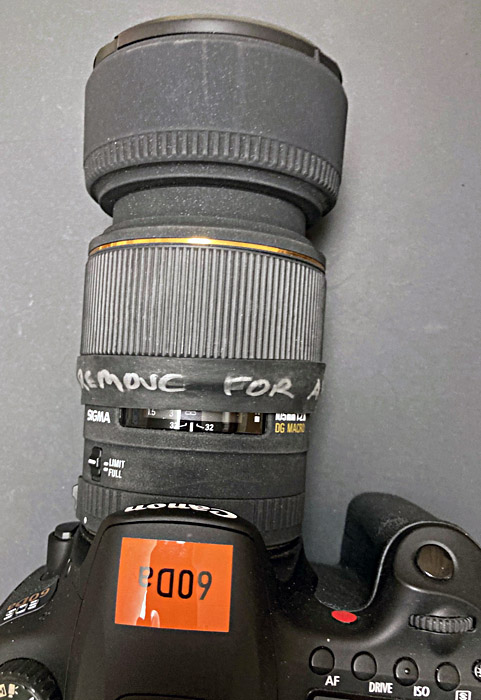
(Now marked "REMOVE FOR AF" to remind me to take it off when autofocus will be
used. With the rubber band on the lens, it can be focused by hand — which
is how I want it — but the autofocus motor would probably not be able to
overpower it and might be damaged.)
It worked well. Here you see the galaxy M33, far from my best image of it,
but this one was taken with a lens normally considered too small for this
kind of work.
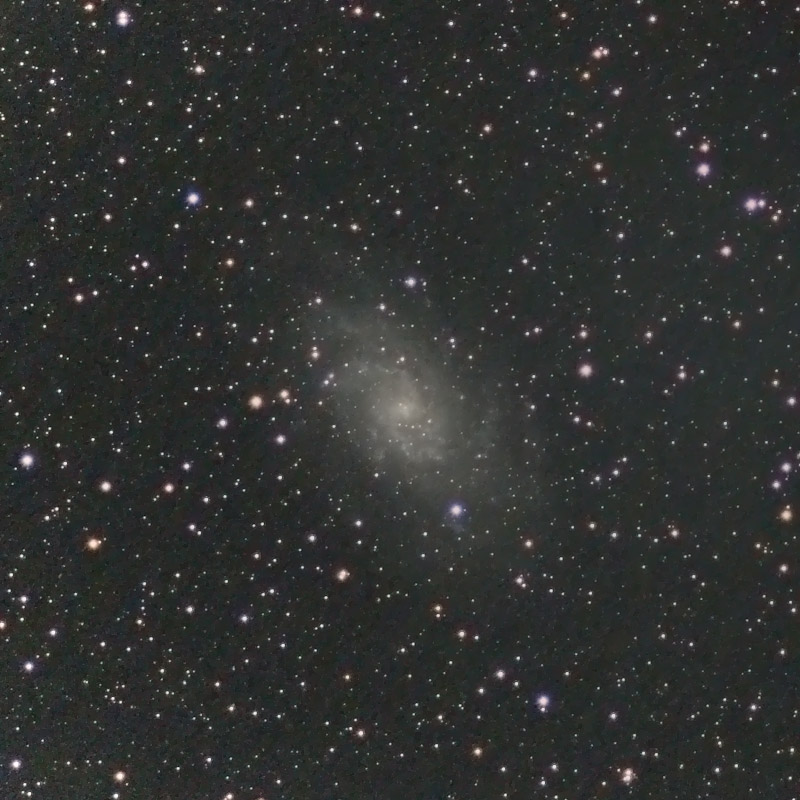
This is a cropped, not downsampled, 800×800-pixel section
of the picture. I stacked 120 30-second exposures (Canon 60Da, ISO 800 iOptron SkyTracker)
and used BlurXTerminator to polish up the images, though this part of the picture did not
change appreciably when that was done. This time I had the lens set to f/2.8 and determined
that, with BlurXTerminator in the workflow, it produces fine images at f/2.8.
Permanent link to this entry


|
2024
December
1
|
Using a rubber band to get sharper astrophotos
Last month I had some trouble with my Sigma 105/2.8 DG EX telephoto lenses
(both of them, one for Canon and one for Nikon) slipping out of focus during
long astrophoto exposures. I found they could do it even left alone on the table indoors
with the lens pointing straight up; if I put it exactly on the infinity mark, it would
shift over the next few minutes under its own weight.
Sigma told me they no longer service this lens (???!). Through the grapevine I learned
that it tends to loosen up with age due to wear on plastic parts, and this does not affect
it when autofocus is on (which is how normal people use it).
It occurred to me that I might use a rubber band to keep the barrel from rotating.
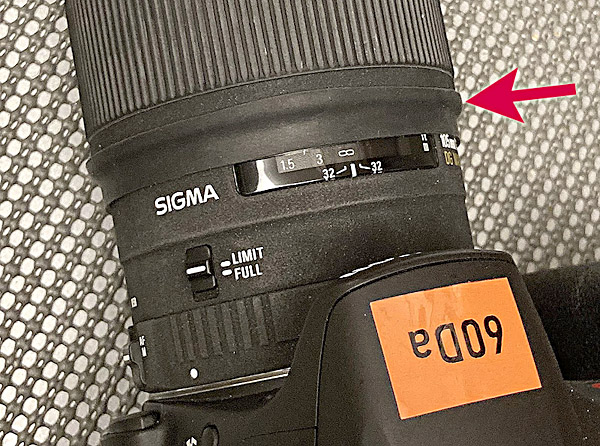
This is a #82 rubber band. I'm going to try a #94, which is wider but does not fit
as tightly. The goal is to make the barrel hard to turn, not impossible.
(There are many numbered sizes of rubber bands, but only a few of them are actually made.
I got mine as "tactical rubber bands" from Amazon. Note that sellers normally give you the
unstretched flat length of the rubber band; the unstretched diameter is 2/π = 64%
of that size.)
|
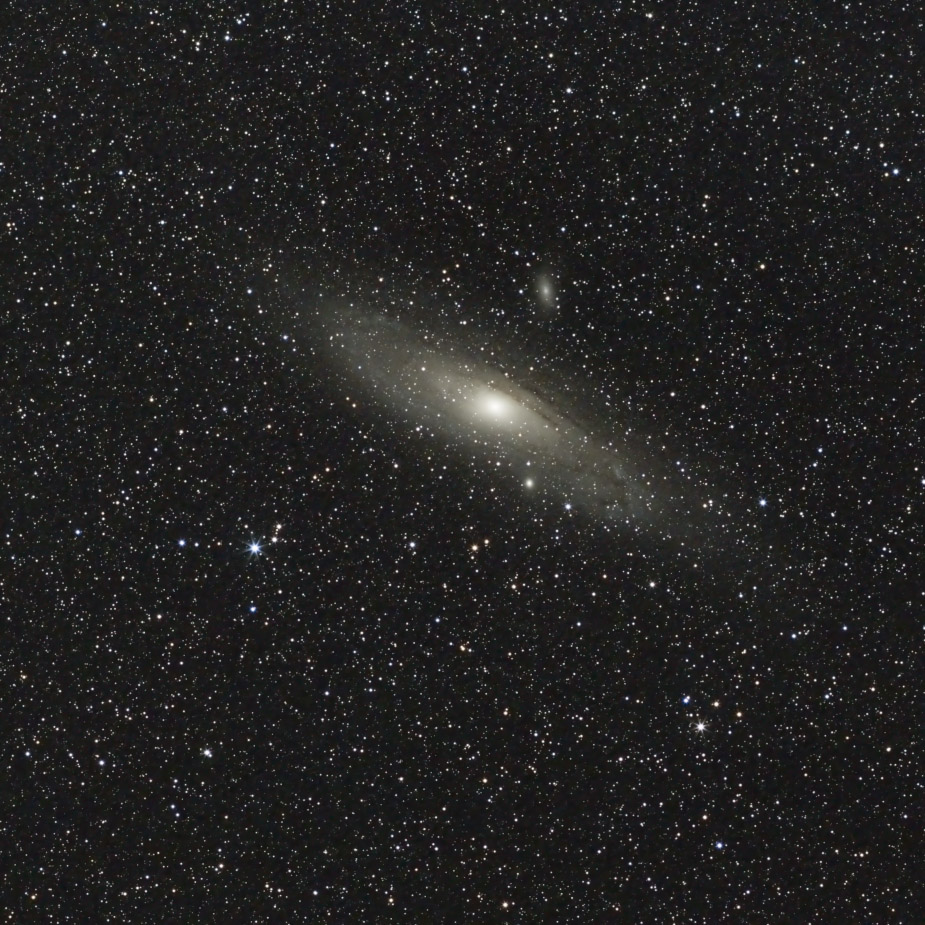
|
| |
The results were very satisfactory! Here is a stack of 142, yes, 142 30-second exposures of
the field of M31, taken with a Canon 60Da at ISO 800 on an iOptron SkyTracker in my driveway.
This is a cropped portion of the image, downsampled only ×2 so that you can see that
it is clearly in focus.
If you have been away from the Daily Notebook for a few days, please click "Previous month"
below. I posted a lot at the end of November and made some last-minute corrections.
Permanent link to this entry


|
| |

|
|
|
This is a private web page,
not hosted or sponsored by the University of Georgia.
Copyright 2024 Michael A. Covington.
Caching by search engines is permitted.
To go to the latest entry every day, bookmark
https://www.covingtoninnovations.com/michael/blog/Default.asp
and if you get the previous month, tell your browser to refresh.
Portrait at top of page by Sharon Covington.
This web site has never collected personal information
and is not affected by GDPR.
Google Ads may use cookies to manage the rotation of ads,
but those cookies are not made available to Covington Innovations.
No personal information is collected or stored by Covington Innovations, and never has been.
This web site is based and served entirely in the United States.
In compliance with U.S. FTC guidelines,
I am glad to point out that unless explicitly
indicated, I do not receive substantial payments, free merchandise, or other remuneration
for reviewing or mentioning products on this web site.
Any remuneration valued at more than about $10 will always be mentioned here,
and in any case my writing about products and dealers is always truthful.
Reviewed
products are usually things I purchased for my own use, or occasionally items
lent to me briefly by manufacturers and described as such.
I am no longer an Amazon Associate, and links to Amazon
no longer pay me a commission for purchases,
even if they still have my code in them.
|
|





















